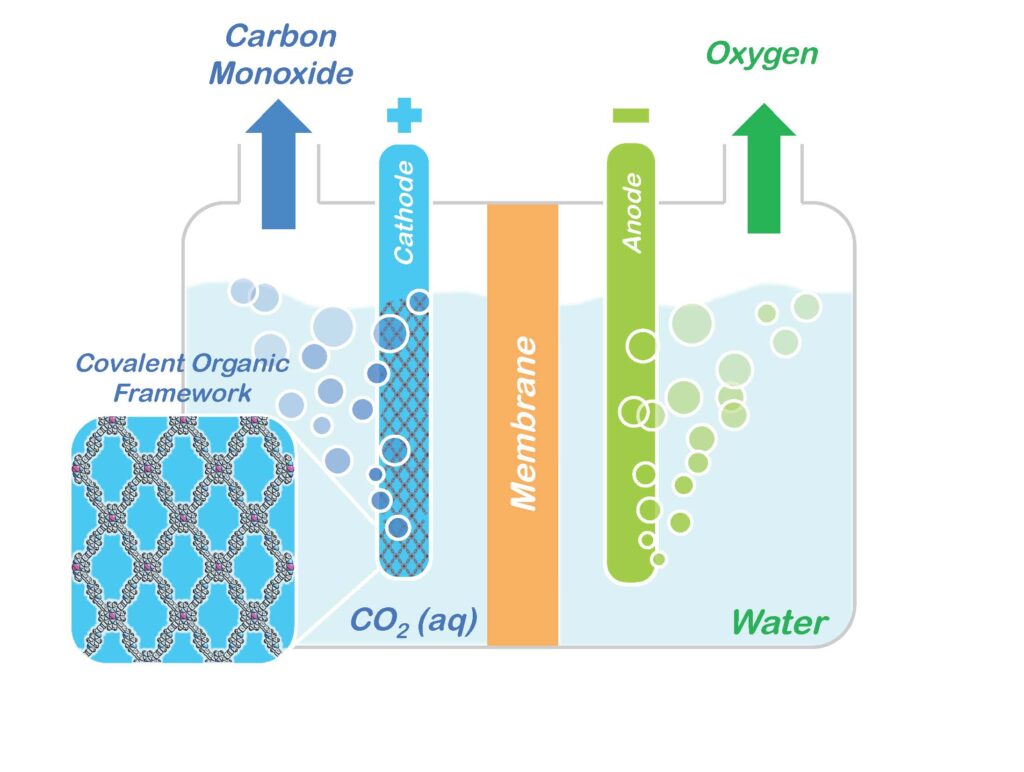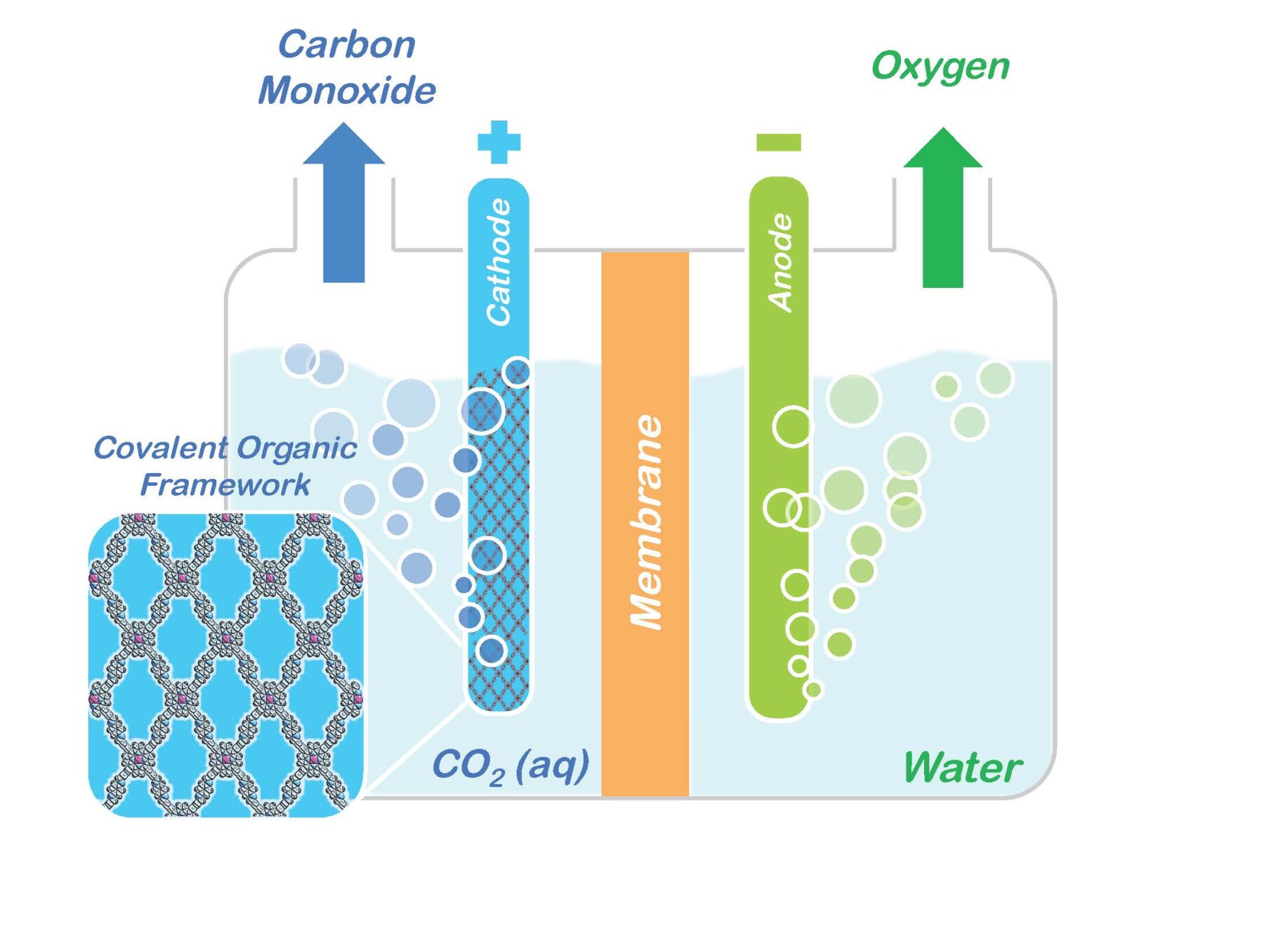
A molecular system that holds great promise for the capture and storage of carbon dioxide has been modified so that it now also holds great promise as a catalyst for converting captured carbon dioxide into valuable chemical products.
The sponge-like quality of a COF’s vast internal surface area enables the system to absorb and store enormous quantities of targeted molecules, such as carbon dioxide.
Researchers with the U.S. Department of Energy (DOE)’s Lawrence Berkeley National Laboratory (Berkeley Lab) have incorporated molecules of carbon dioxide reduction catalysts into the sponge-like crystals of covalent organic frameworks (COFs). This creates a molecular system that not only absorbs carbon dioxide, but also selectively reduces it to carbon monoxide, which serves as a primary building block for a wide range of chemical products including fuels, pharmaceuticals and plastics.
“There have been many attempts to develop homogeneous or heterogeneous catalysts for carbon dioxide, but the beauty of using COFs is that we can mix-and-match the best of both worlds, meaning we have molecular control by choice of catalysts plus the robust crystalline nature of the COF,” says Christopher Chang, a chemist with Berkeley Lab’s Chemical Sciences Division, and a co-leader of this study. “To date, such porous materials have mainly been used for carbon capture and separation, but in showing they can also be used for carbon dioxide catalysis, our results open up a huge range of potential applications in catalysis and energy.”
Chang and Omar Yaghi, a chemist with Berkeley Lab’s Materials Sciences Division who invented COFs, are the corresponding authors of a paper in Science that describes this research in detail. The paper is titled “Covalent organic frameworks comprising cobalt porphyrins for catalytic CO2 reduction in water.” Lead authors are Song Lin, Christian Diercks and Yue-Biao Zhang. Other co-authors are Nikolay Kornienko, Eva Nichols, Yingbo Zhao, Aubrey Paris, Dohyung Kim and Peidong Yang.
Chang and Yaghi both hold appointments with the University of California (UC) Berkeley. Chang is also a Howard Hughes Medical Institute (HHMI) investigator. Yaghi is co-director of the Kavli Energy NanoScience Institute (Kavli-ENSI) at UC Berkeley.
The notoriety of carbon dioxide for its impact on the atmosphere and global climate change has overshadowed its value as an abundant, renewable, nontoxic and nonflammable source of carbon for the manufacturing of widely used chemical products. With the reduction of atmospheric carbon dioxide emissions in mind, Yaghi and his research group at the University of Michigan in 2005 designed and developed the first COFs as a means of separating carbon dioxide from flue gases. A COF is a porous three-dimensional crystal consisting of a tightly folded, compact framework that features an extraordinarily large internal surface area – a COF the size of a sugar cube were it to be opened and unfolded would blanket a football field.
The sponge-like quality of a COF’s vast internal surface area enables the system to absorb and store enormous quantities of targeted molecules, such as carbon dioxide.
Read more: Soaking Up Carbon Dioxide and Turning it into Valuable Products
The Latest on: Covalent organic frameworks
[google_news title=”” keyword=”covalent organic frameworks” num_posts=”10″ blurb_length=”0″ show_thumb=”left”]
via Google News
The Latest on: Covalent organic frameworks
- Key to efficient and stable organic solar cellson April 24, 2024 at 5:00 pm
Their research, titled "The role of interfacial donor-acceptor percolation in efficient and stable all-polymer solar cells," paves the way for more sustainable and viable solar energy solutions for ...
- When nano- meets climate technologyon April 22, 2024 at 4:59 pm
Other classes of reticular materials, such as covalent organic frameworks and hydrogen-bonded organic frameworks, hold similar potential to attain high hydrogen storage density at low pressure. An ...
- Hazardous Waste Newson April 15, 2024 at 5:00 pm
Apr. 16, 2024 — Scientists have found a way to transform metal waste into a highly efficient catalyst to make hydrogen from water, a discovery that could make ... Apr. 9, 2024 — Scientists are ...
- Improving pore performanceon April 8, 2024 at 12:13 pm
A drying procedure using supercritical carbon dioxide gives greater access to the pores of metal–organic ... offered by frameworks based on coordination bonds and covalent bonds.
- Recent advances and perspectives of covalent organic frameworks for alkali-ion batterieson March 21, 2024 at 7:01 am
Xu said that covalent organic framework (COF) materials exhibit several advantageous characteristics and demonstrate excellent electrochemical performance. Their unique network framework provides ...
- Study shows 3D-covalent organic frameworks can be tuned using structural isomerson March 6, 2024 at 7:21 am
More information: Xiaohan Wang et al, Triple Isomerism in 3D Covalent Organic Frameworks, Journal of the American Chemical Society (2024). DOI: 10.1021/jacs.3c13863 Provided by Tokyo Institute of ...
- Covalent Organic Frameworks – Design and Functionon February 25, 2024 at 3:58 am
This organic composition of COFs allows for a lighter material ... Involves the reaction of boronic acids with diols to form boronate esters, creating a robust framework through reversible covalent ...
- What is a MOF (metal organic framework)?on January 21, 2024 at 11:49 pm
Metal-organic frameworks (MOFs) are organic-inorganic hybrid crystalline porous materials that consist of a regular array of positively charged metal ions surrounded by organic 'linker' molecules. The ...
- Ashlee J. Howarth, PhDon December 12, 2022 at 1:21 pm
covalent–organic frameworks (COFs), and metal–organic frameworks (MOFs). Recent literature will be used to highlight potential applications and key advances relevant to each class of porous materials.
- Assistant Professor of Chemistryon September 21, 2019 at 2:44 am
Danyon M. Fischbach*, Grace Rhoades*, Charlie Espy*, Fallon Goldberg*, and Brian J. Smith. "Controlling the crystalline structure of imine-linked 3D covalent organic ...
via Bing News











